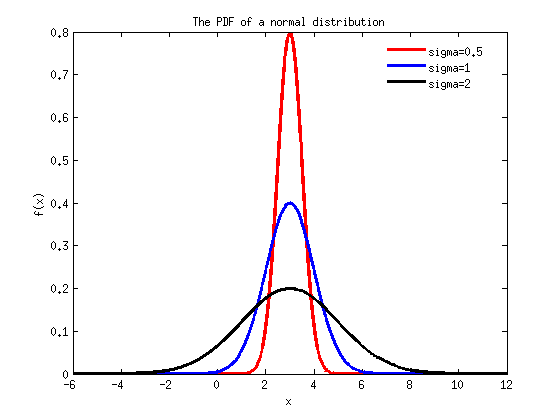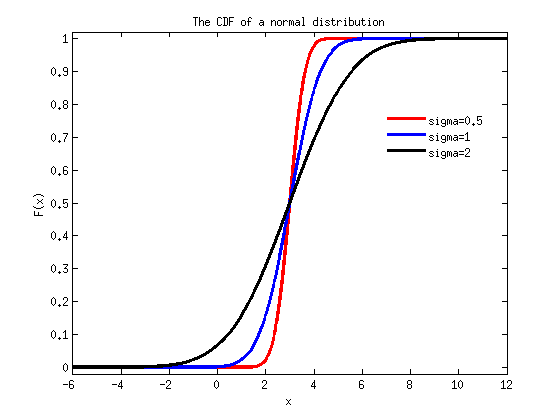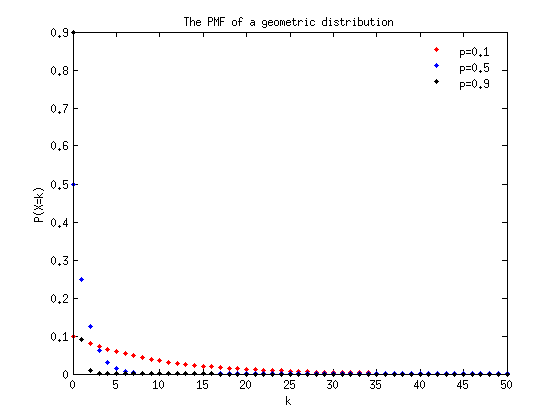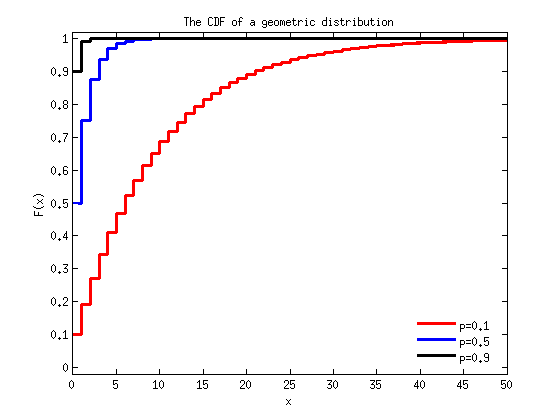Lab 3, Discrete, continouse distribution. SOLUTION (Due on 11:59 PM, Feb 17, 2015)
Contents
Assignments
Here goes the assignments for Lab 3.
Question 1. Plot the PDF and CDF for normal distribution with fixed  and varying
and varying ![$\sigma = [0.5, 1, 2]$](Lab3_solution_eq19836.png) . Draw your observations with two to three sentences.
. Draw your observations with two to three sentences.
mu=3;
sigma=[0.5 1 2];
xs=-6:0.0001:12;
linestyle={'r-','b-','k-'};
%plot the PDF of a normal distribution fig1=figure; for i=1:3 f=normpdf(xs,mu,sigma(i)); plot(xs,f,linestyle{i},'linewidth',3); hold on; end title('The PDF of a normal distribution'); xlabel('x');ylabel('f(x)'); legend('sigma=0.5','sigma=1','sigma=2','location','best'); legend('boxoff');

plot the CDF of a normal distribution
fig2=figure; for i=1:3 F=normcdf(xs,mu,sigma(i)); plot(xs,F,linestyle{i},'linewidth',3); hold on; end title('The CDF of a normal distribution'); xlabel('x');ylabel('F(x)');ylim([-0.02 1.02]); legend('sigma=0.5','sigma=1','sigma=2','location','best'); legend('boxoff')

Observations: PDF: All three plots have the same median (mu, in this case 3). The smaller sigma is, the higher and narrower the peak in the middle of the plot (around x=3). CDF: The smaller sigma is, the steeper and closer to vertical the corresponding plot is. All three plots go through the same point at F(x) = 0.5 (which is the median).
Question 2. Plot the PMF and CDF for geometric distribution with varying ![$p=[0.1, 0.5, 0.9]$](Lab3_solution_eq22937.png) .
.
p=[0.1 0.5 0.9]; ks=0:50;
plot the PMF of a geometric distribution
fig3=figure;
linestyle={'r.','b.','k.'};
for i=1:3
P=geopdf(ks,p(i));
plot(ks,P,linestyle{i},'markersize',13.5);
hold on;
end
title('The PMF of a geometric distribution');
xlabel('k');ylabel('P(X=k)');
legend('p=0.1','p=0.5','p=0.9','location','best');
legend('boxoff');

%plot the CDF of a geometric distribution fig4=figure; linestyle={'r-','b-','k-'}; for i=1:3 F=geocdf(ks,p(i)); stairs(ks,F,linestyle{i},'linewidth',3); hold on; end title('The CDF of a geometric distribution'); xlabel('x');ylabel('F(x)');ylim([-0.02 1.02]); legend('p=0.1','p=0.5','p=0.9','location','best'); legend('boxoff');

Observations: PMF: The larger p is, the more quickly f(x) approaches 0. CDF: The larger p is, the more quickly F(x) approaches 1.
Submission. Put all of your code, figures, writeups in a single document with .doc or .docx or .pdf format. Submit the document through blackboard. Attention, .txt format is not acceptable.